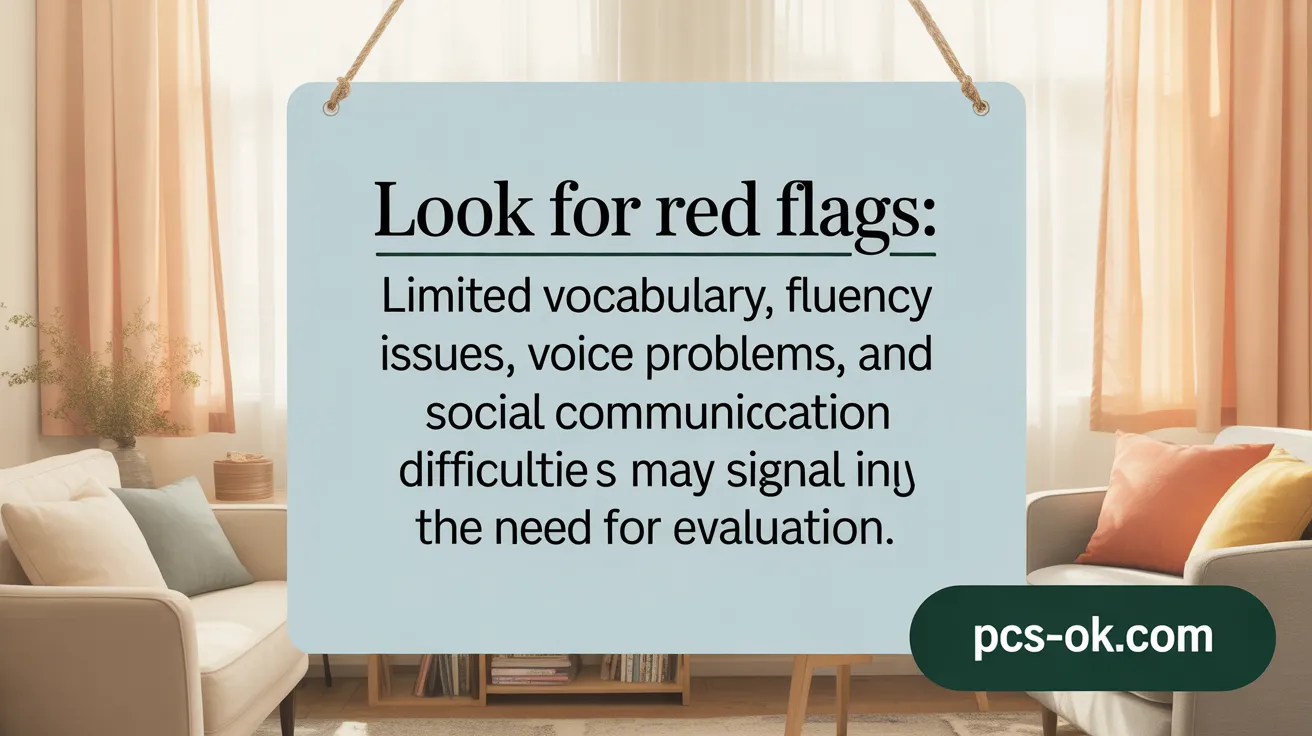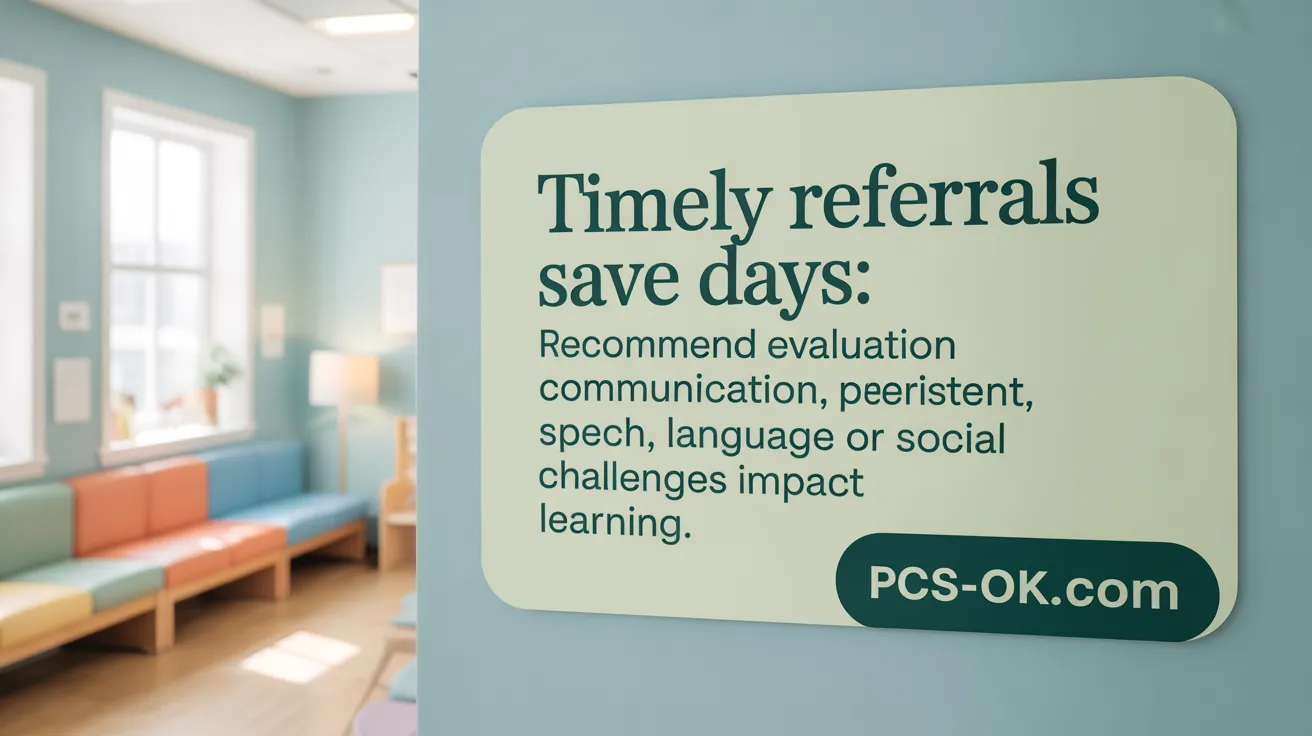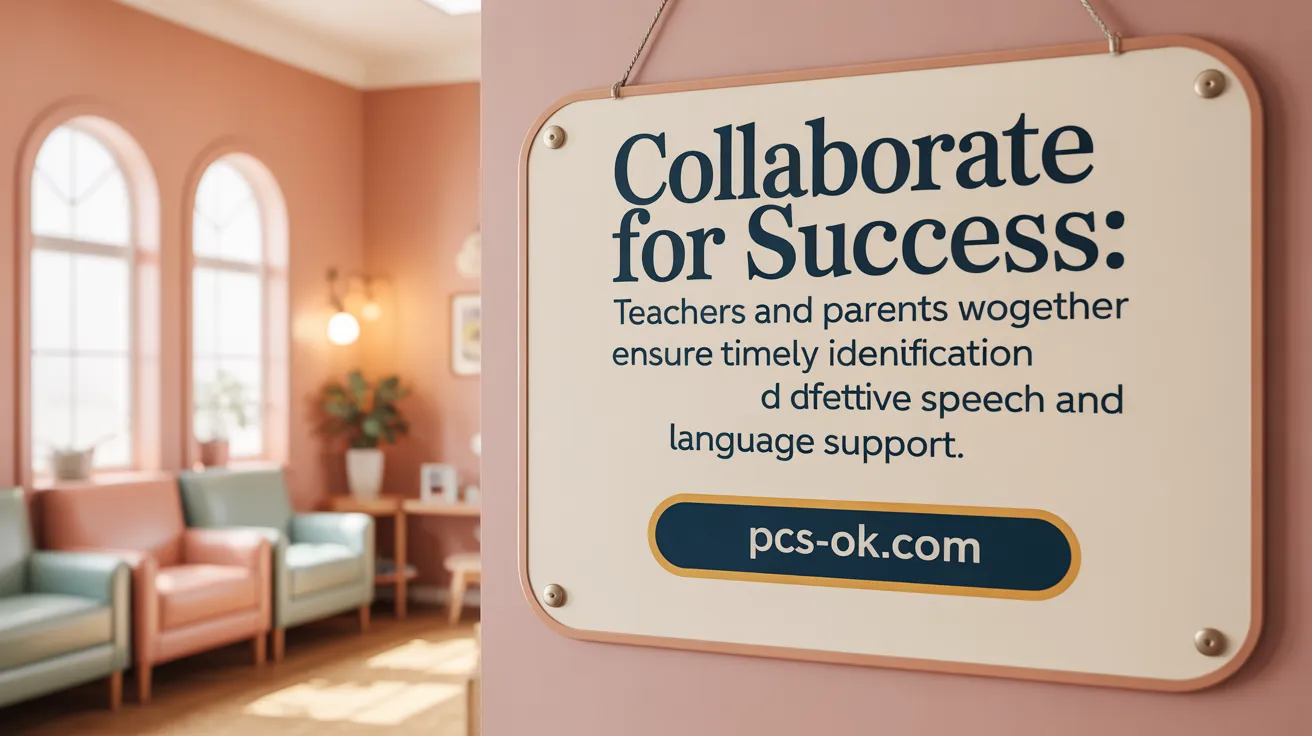When Teachers Recommend a Speech-Language Evaluation
Understanding the Role of Teachers in Speech-Language Evaluations
Teachers often serve as the first observers of speech and language challenges in students. Recognizing when to recommend a speech-language evaluation is crucial to ensuring students receive the support they need to succeed academically and socially. This article explores the indicators teachers should watch for, the evaluation referral process, and the collaborative role of educators, speech-language pathologists (SLPs), and parents in addressing communication disorders within educational settings.
Recognizing Signs That Warrant a Speech-Language Evaluation

What are the signs that indicate a student might need a speech-language evaluation?
Identifying when a child needs a speech-language assessment is crucial for early intervention. Students who show delays in meeting developmental milestones are often the first to warrant attention. For example, if a child has not said their first words by 14 months or does not combine words into simple sentences by age 2, these can be indicators of concern.
Observable communication difficulties in the classroom also provide vital clues. Students who consistently mispronounce sounds more than 20% of the time, making them hard to understand, especially in comparison to age-appropriate speech development charts, may require evaluation. Moreover, limited vocabulary, trouble forming sentences, or slow language growth are signs that something may need professional assessment.
Other common speech disorders include articulation problems, where children struggle with pronouncing sounds correctly, and fluency issues like stuttering, characterized by involuntary repetitions, body tension, or blinking. Voice problems, such as hoarseness or pitch issues, can also affect effective communication.
Social communication challenges can significantly impact a child’s success and interactions. Difficulties in following instructions, answering questions, or asking questions themselves might reveal a language processing issue. Challenges in understanding or engaging with social cues, joining conversations, or maintaining age-appropriate interactions are also red flags.
It’s important to recognize that cultural and linguistic differences can sometimes mimic speech or language delays. Teachers and parents should consider whether communication differences stem from bilingual backgrounds or dialectal variations before pursuing evaluations.
Early identification through observation and awareness ensures children receive the support they need to develop effective communication skills. Schools rely on careful monitoring, and teachers play a vital role in noticing these signs and initiating referrals for speech-language evaluation.
When and Why Teachers Should Recommend a Speech-Language Evaluation

What observations and data do teachers collect to identify speech or language concerns?
Teachers are often the first to notice signs that a student might be struggling with speech or language skills. They observe how clearly a child pronounces words, how well they follow directions, and if they seem to have trouble answering questions or understanding stories. Teachers document specific examples, such as mispronounced sounds, frequent repetitions, or difficulty communicating thoughts.
In addition to speech clarity, teachers watch for language comprehension issues, like understanding instructions or questions, and expressive language problems, such as asking questions or describing ideas. They also note behaviors related to voice and fluency, including any signs of stuttering or voice quality problems.
This observational data is crucial for informing further evaluation and ensuring that concerns are backed by solid examples. Teachers should also consider cultural or linguistic backgrounds to differentiate between language differences and disorders.
When should teachers recommend a speech-language evaluation for a student?
Teachers should suggest an evaluation when they notice persistent and significant difficulties that impact a student’s ability to participate and learn. For articulation issues, signs include unclear speech and difficulty pronouncing sounds more than 20% of the time, especially if they interfere with intelligibility.
Language comprehension and expression concerns include trouble following instructions, answering questions, or communicating ideas clearly. If these issues are observed consistently, especially despite classroom interventions, a referral is appropriate.
For voice, persistent problems like a hoarse voice or abnormal pitch should be evaluated. Regarding fluency, children who stutter frequently and across settings, or show signs of body tension or blinking during speech, should be assessed.
Teachers should ensure that their concerns are supported by specific examples and consider cultural and linguistic factors to avoid misdiagnosis. Referral should be part of a thoughtful process involving data collection, collaboration with SLPs, and parental input.
The influence of cultural sensitivity in referrals
Cultural and linguistic diversity can influence how speech and language issues are perceived. Teachers should be cautious and ensure that observed difficulties are not simply differences in dialect or language background. When in doubt, collaboration with SLPs familiar with bilingual and multicultural populations can prevent misidentification and ensure accurate assessment.
How do speech and language issues impact students’ academic and social skills?
Problems with speech and language can hinder a child’s ability to succeed academically. They may struggle with reading, writing, vocabulary, and following classroom instructions. Socially, these children might find it hard to maintain conversations, make friends, or interpret social cues, impacting their overall well-being.
Early identification and intervention can help mitigate these effects, supporting better educational outcomes and social development.
Legal and educational frameworks guiding referrals
The IDEA (Individuals with Disabilities Education Act) sets guidelines for evaluating and supporting students with speech and language needs. Referrals follow a formal process involving data collection, parental consent, and comprehensive assessments. Evaluations typically include standardized tests, observations, and review of educational performance.
Teachers play a vital role in this process by providing detailed observations and collaborating with specialists. Ensuring culturally appropriate assessments and respecting legal rights helps facilitate fair and effective identification and intervention.
| Aspect | Description | Additional Notes |
|---|---|---|
| Observation | Collect examples of mispronunciations, comprehension issues | Supports referral decision-making |
| Referral Criteria | Significant articulation, language, voice, fluency issues | Based on persistent classroom observations |
| Cultural Sensitivity | Different dialects or languages vs. disorders | Collaborate with bilingual SLPs |
| Impact | Academic delays, social communication problems | Early detection improves outcomes |
| Legal Framework | IDEA, parent consent, comprehensive assessment | Ensures rights and proper support |
Understanding when and why teachers should recommend a speech-language evaluation helps support students in need of communication assistance, ultimately fostering their success in school and social integration.
Navigating the Speech-Language Evaluation Referral Process in Schools
What is the process for referring a student for a speech-language evaluation in an educational setting?
The process starts when teachers, parents, or other involved team members notice speech or language difficulties that may require professional assessment. They initiate a referral, often through a form or checklist designed to gather relevant observations and concerns. This documentation includes specific examples such as difficulty making sounds, understanding spoken language, or expressing ideas clearly.
Once the referral is received by the school, the district has a set period—usually twenty calendar days—to convene a meeting. During this time, educators and specialists review the concerns and decide whether an evaluation is warranted. Parental permission is essential for proceeding; thus, the school must obtain written consent before conducting any assessment.
If the team agrees to move forward, the student undergoes a comprehensive evaluation involving standardized tests—like articulation and language assessments—as well as non-standardized observations and work sample analyses. These evaluations aim to determine if the student qualifies for speech and language services, which are typically provided within ninety days of receiving parental consent.
Throughout this process, clear communication, proper documentation, and early cooperation are vital. Teachers play a crucial role in providing detailed observations, helping to ensure an efficient referral procedure. Engaging parents early and explaining the purpose of evaluations can also foster a supportive environment conducive to timely intervention.
By following these steps and maintaining open lines of communication among teachers, families, and specialists, schools can effectively address students’ speech and language needs, ultimately supporting their academic and social development.
Tools and Techniques Used to Identify the Need for Speech Therapy
In schools, identifying students who may benefit from speech therapy involves a variety of tools and techniques to ensure a thorough and accurate assessment. Commonly, standardized screening and assessment instruments are used, which provide reliable measures of a child’s communication abilities. These tools are often norm-referenced or criterion-referenced, helping professionals determine whether a child’s speech and language skills fall within typical ranges or require intervention.
Apart from formal tests, questionnaires and checklists are invaluable for gathering insights from those who observe the child regularly. Instruments like the Children’s Communication Checklist (CCC-2) offer detailed information about various aspects of communication, including social language use, speech sounds, and expressive language. Parents, teachers, and even students themselves can complete these reports to paint a comprehensive picture.
Observation-based methods are also crucial. Naturalistic approaches, such as language sampling, ethnographic interviews, and everyday classroom observations, allow clinicians and educators to see how children communicate in real-life situations. These methods help spot issues like inconsistent speech, pragmatic challenges, or difficulties understanding or following instructions.
Further, dynamic assessments and curriculum-based evaluations are employed to evaluate how children respond to intervention strategies and how their language skills align with classroom demands. These assessments help determine whether targeted therapy could support the child’s educational success.
Assessments must also respect cultural and ecological contexts to accurately reflect a child’s communication abilities. This means selecting tests and observation strategies that are valid and relevant to the child’s background and everyday environment.
By combining standardized tests, informal observations, and report measures, speech-language pathologists, teachers, and parents can effectively identify children who need further evaluation and potentially speech therapy, paving the way for timely intervention.
Supporting Students Through Evaluation and Intervention: The Collaborative Role of Teachers and Parents

Why and under what circumstances is a speech-language evaluation appropriate for a student?
A speech-language evaluation becomes necessary when a student shows persistent communication difficulties that interfere with learning, social participation, or behavior. Signs include articulation problems, language comprehension issues, voice concerns, or fluency disorders like stuttering. Such challenges are not typical developmental delays and may warrant diagnosis and intervention.
Evaluation should be comprehensive, combining standardized tests, language samples, classroom observations, and interviews with parents and teachers. It considers cultural, linguistic, and cognitive factors and complies with federal guidelines like IDEA, which delineates the criteria for qualifying for special education services. Usually, the goal is to determine if a communication disorder exists and whether specialized support can help the student succeed academically and socially.
How can parents and teachers recognize speech and language problems that require formal assessment?
Teachers and parents are often the first to notice difficulties that merit professional attention. Common indicators include delayed speech development, difficulty understanding instructions, mispronunciations impacting clarity, or limited vocabulary.
Observing frequent misunderstandings or social withdrawal related to communication challenges is crucial. For example, a student who avoids speaking, struggles to follow directions, or cannot answer questions appropriately may need a formal assessment. Additionally, if the child’s speech is unintelligible more than 20% of the time, or if progress stalls despite interventions, it suggests an underlying issue.
Early identification through vigilant observation allows timely referrals. Recognizing these signs ensures children receive appropriate evaluations and supports, maximizing their potential for successful communication.
Ensuring Timely Support Through Teacher Recommendations
Teachers play a pivotal role in identifying speech and language difficulties that affect students’ academic success and social integration. By understanding the signs that warrant evaluation, following structured referral procedures, and collaborating closely with speech-language pathologists and families, educators help facilitate timely access to critical speech therapy services. Equipped with the right tools and knowledge, teachers are vital advocates who contribute to creating supportive learning environments and improving communication outcomes for all students.
References
- When to Refer a Student for Speech Therapy
- When to Refer to Speech Therapy: A Teacher Guide
- Your Child’s Speech/Language Evaluation at School
- Assessment and Evaluation of Speech-Language …
- Services – Speech Therapy
- Frequently Asked Questions – Speech and Language …
- Make the Speech Referral Process Work for You
- 7 Signs Your Child May Benefit from Speech Therapy
- How to Tell if Your Student Could Benefit From Speech …
- Top 10 Signs Your Child Might Need Speech Therapy

Baby learning stages is crucial for lifelong learning.
Childcare providers can enhance speech and communication skills using
interactive tools. Multisensory tools encourage communication with engaging techniques.
Infant and toddler learning toys develop hand-eye coordination enhancing feeding skills.
Speech-language therapists implement targeted therapy methods to
stimulate brain growth. Toddler feeding tools reduce mealtime stress
and can be paired with oral sensory stimulation tools.
Special needs educational toys improve communication skills
providing multisensory experiences. Personalized learning plans are most effective when combined with caregiver engagement.
Adaptive toddler plates encourage motor coordination while allowing parents to monitor progress.
Speech therapy resources during play sessions to strengthen social interaction. Fine motor skill exercises encourage confidence
and independence and complement sensory integration exercises.
Newborn must-haves help ensure healthy growth for effective caregiving.
Soothing remedies enhance physical well-being alongside therapeutic play.
Portable accessories keep essentials accessible to maintain developmental support.
Infant nutrition support energy and brain function as part of structured mealtimes.
Speech challenges in infants improve with consistent support.
Mouth muscle stimulators support feeding skills with interactive play.
Visual-motor play help children regulate emotions and complement therapy
tools. Autism support tools boost confidence through engaging approaches.
Customized skill-building plans work best with caregiver involvement.
Feeding therapy utensils support oral motor development while complementing fine motor exercises.
Dexterity-building tools enhance writing readiness
while integrating with learning toys. Balance and coordination exercises enhances
confidence in daily play schedules. Baby gear must-haves simplify daily routines with eco-friendly options.
Soothing blankets supports sensory regulation alongside developmental activities.
Stroller organizers support mobile caregiving while encouraging positive
interaction. Age-appropriate snacks reinforces oral motor skills while supporting
overall development. Adaptive utensils support sensory exploration and complement therapeutic exercises.
Interactive learning tools integrated into play sessions improve articulation while engaging
children. Jaw-strengthening toys improve overall oral function in fun daily routines.
Inclusive developmental tools enhance engagement through interactive methods.
Early intervention programs work best with consistent practice.
Specialty feeding equipment help build independence alongside fine
and gross motor activities.
Toddler learning toys develop attention span while
being fun and safe. Stimulating baby products encourage curiosity while complementing therapy sessions.
Expressive language boosters can be integrated into play via
structured therapy. Special needs development tools enhance focus
through fun and interactive methods. Behavior support resources improve task completion with consistent routines.
Oral motor development toys enhance speech clarity as part of
daily routines. Child-friendly spoons encourage oral sensory exploration through structured exercises.
Manipulative play activities strengthen overall coordination as
part of therapy sessions. Large muscle activities improve coordination while combining fun and learning.
Home-based developmental activities support long-term growth alongside toys and therapy.
Child safety and comfort tools promote healthy growth through consistent use.
Soft clothing support emotional regulation with caregiver supervision. Stroller organizers help manage daily routines alongside therapy activities.
Healthy feeding options enhance brain development while complementing therapy tools.
Child-centered mealtime items support independence alongside speech therapy
routines. Speech therapy resources boost
confidence with caregiver involvement. Jaw-strengthening toys stimulate oral muscles while
being playful. Adaptive skill-building resources develop problem-solving with caregiver guidance.
Speech-language routines reinforce long-term skills in daily routines.
Specialty feeding solutions encourage oral sensory exploration through structured exercises.
Also visit my blog … gentle-transition learning cup
Beginning stages of child development
shapes long-term learning abilities.
Family members involved in caregiving
should encourage
foundational vocabulary building
via interactive learning experiences.
Sensory-based tools
promote communication growth
as part of fun routines.
Early-growth educational items
build coordination
and assist oral motor readiness.
Parents noticing late communication skills
apply targeted language strategies
to minimize developmental gaps.
Child-friendly dining utensils
help make meal times calmer
and work with oral-sensory tools.
ADHD-oriented cognitive aids
allow personalized learning paths
while staying fun.
Speech-guided learning sessions
perform best when integrated with
home-based learning support.
Child-focused feeding items
support healthy eating patterns
as part of routine activities.
Games that build early literacy
fit well in home settings
to expand expressive abilities.
Large movement activities
enhance agility and strength
while elevating cognitive growth.
Core items for new parents
cover rest, nutrition, hygiene, and play
and fit naturally into daily habits.
Soft baby wear
assist emotional regulation
balanced with therapeutic play.
Travel-friendly organizers
improve day-to-day convenience
ensuring safety and comfort.
Formula and solid-food solutions
help maintain healthy development
used together with feeding therapy items.
Toddlers with emerging speech challenges
respond well to early guidance.
Oral strengthening toys
increase confidence when speaking
as part of daily activities.
Hands-on emotional regulation tasks
support focus and calm
and pair well with therapeutic tools.
Development aids for unique learners
elevate confidence levels
with easy-to-use guidance.
Skill-focused daily schedules
thrive with caregiver support
alongside helpful educational items.
Children’s self-eating helpers
support exploratory feeding
blended with speech activities.
Fine motor improvement toys
support reading-readiness skills
while blending with skill toys.
Gross motor coordination games
boost healthy strength
while mixing fun with learning.
Structured learning programs
grow best with routine involvement
with planned activities.
Infant-to-toddler support products
support early learning moments
in caregiver-led environments.
Relaxing sleep accessories
enhance emotional ease
fitting into daily calm routines.
Childcare mobility tools
improve travel safety
in mobile caregiving situations.
Nutrient-focused feeding choices
boost growth
while pairing with feeding tools.
Plates and utensils made for toddlers
minimize frustration
implemented during daily meals.
Communication-building tools
boost self-confidence
during routine skill-building.
Muscle-building mouth tools
support feeding ability
within fun daily routines.
Adaptive play tools
encourage deep engagement
through interactive learning.
Early-learning improvement plans
grow with caregiver teamwork
through multisensory learning.
Child-sized feeding equipment
promote sensory feeding awareness
used in daily activities.
Feel free to visit my website :: skin-safe baby creams